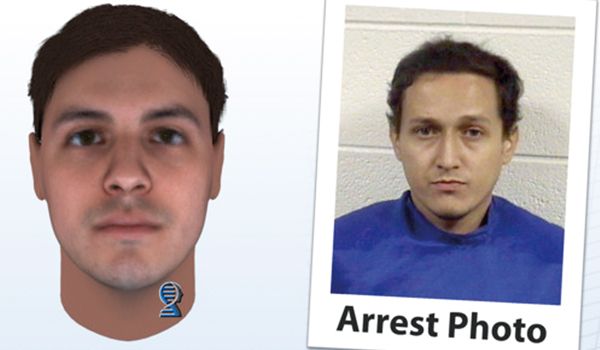Facing the future
DNA has revolutionised criminal identification but its use continues to develop with phenotyping providing major breakthroughs in recent murder investigations.
When DNA phenotyping the process of obtaining information about a subjects appearance purely from their DNA sample first emerged as a new technique for criminal investigators it seemed more science fiction that science fact. But newly-released details of its ability to accurately depict the likeness of a suspect will inevitably hasten its adoption into mainstream policing. DNA phenotyping first grabbed public attention in January last year when US police in Columbia, South Carolina, issued a picture of a suspect wanted for the 2011 murder of Candra Alston and her three-year-old daughter, Malaysia. It was the first image in forensic history to be created entirely on the basis of a DNA sample found at the crime scene. This earliest incarnation of the technique allowed researchers to determine a suspects eye, skin and hair colour, as well as their ethnic or racial background. Since then, phenotyping has been further refined to enable it to give a much clearer picture of a persons facial shape. Furthermore, by tracking the changes in DNA as people age, phenotyping can now significantly narrow down the age range of a suspect it is the equivalent of having a reliable eyewitness to a crime. Although DNA phenotyping has since been used in a number of other cases to create e-fits of suspects, the conviction of the killer of Troy and LaDonna French in the US was one of the first in which detectives were able to compare the suspect to the phenotype image and determine the accuracy of the technique. Although the killer was jailed last summer, it is only this month that the company behind the image has been able to share the extent of its involvement. The case began in the early hours of February 4, 2012, when Troy and Ladonna woke to the sound of screams from their 19-year-old daughter, Whitley, when a hooded intruder broke into her bedroom in the familys North Carolina home. As the couple ran to their daughters aid, the man tried to keep the girl quiet by holding a knife to her throat, cutting himself in the process. When this failed, he released her and ran towards the stairs while swapping his knife for a handgun. As the couple approached the stairwell, the intruder opened fire, killing them both. He then fled, leaving a few drops of blood on the handrail. With blood from the stairs, the North Carolina State Crime Laboratory produced a full DNA profile. It did not match any of the friends or family who frequented the home, including Whitley, her brother, and her boyfriend at the time, John Alvarez, so police were confident it could be only that of the suspect. Analysing the sample through CODIS the Combined DNA Index System, the biggest database of DNA samples in the US failed to produce a match. Beyond the fact that the suspect was male, detectives had no other clues. As the months passed with no new leads, investigators began collecting DNA samples from anyone thought to have been in or around the French home. We swabbed a lot of people, said Captain Tammi Howell of the Rockingham County Sherriffs Office, who led the investigation. Early on, if there was a remote chance someone could have been connected to the crime, we asked for a swab. In the first 12 months following the crime, more than 50 people consented to provide a DNA sample. None of the samples matched the perpetrator. As the months turned to years and the case remained unsolved, Captain Howell secured new funds to pursue alternative forms of DNA testing. The first break in the case came when familial DNA testing, conducted at the University of North Texas, revealed the possibility that the perpetrator might be related to John Alvarez, Whitleys boyfriend. Because traditional DNA testing is limited in its ability to detect all but the closest relationships, such as parent-child, this report alone did not provide actionable information. Scientists at the University of North Texas then carried out Y-chromosome short tandem repeat (STR) analysis, which tests whether two male DNA samples share a com


